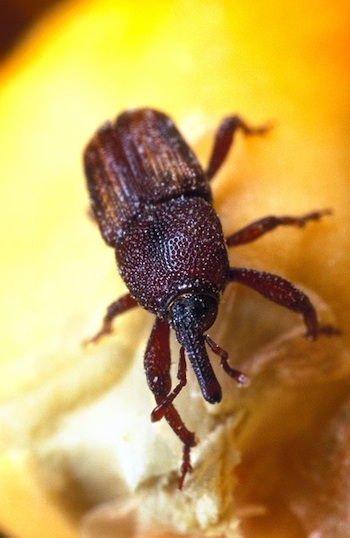For Georgia corn producers, chances of an insect infestation in grain storage are much higher in late summer or early fall. A University of Georgia entomologist says keeping corn cool and dry is the key to keeping weevil away.
“The temperatures are usually warm during harvest, so we bring in corn that’s hot and that really supports a lot of insect growth. It gives us a lot of challenges,” Toews said Michael Toews, an entomologist with the UGA College of Agricultural and Environmental Sciences in Tifton.
What to do
What measures can Georgia corn growers take to thwart off potential insect pests? Toews recommends harvesting dry grain, or running it through the dryer to get the moisture content under 14 percent.
“As grain moisture decreases toward 11 percent, that makes the grain much less likely to support insect growth,” he said.
Grain that is warm and high in moisture is perfect for weevils to reproduce and cause damage. Weevils are cold-blooded beetles so their metabolic rates are dependent on air temperature. If the temperature is 80 or 90 degrees Fahrenheit, the generation time of one adult to the next adult could be as short as four weeks, according to Toews.
If farmers can decrease grain temperature using aeration, it can extend the generation period out to two or three months. And, producers can suppress populations long term by keeping their grain cool.
How to do it
To do so, Toews recommends installing an aeration fan attached to a thermostat located outside the grain bin. Anytime there is a differential of 10-15 F between the cooler outside air and the grain temperature, the fans should be used.
Avoiding infestation is key for corn growers to maintain grain quality, especially when dealing with the threat of the maize weevil, the most dangerous pest a corn grower faces every year.
The maize weevil is an economically devastating insect pest that develops inside a corn kernel. Because it’s out of sight, it can be difficult for a farmer to know there is an infestation until the adults emerge. By then, the damage is already done.
The problem begins when a female chews a small hole in the kernel, deposits an egg and then seals the hole with a plug. The egg hatches inside the kernel where the insect develops through all the immature stages. The adult eventually chews its way out, leaving an exit hole and an empty kernel. The resulting damage downgrades the grain’s quality and causes farmers to receive a lower price for their crop.
“Grain storage is a critical part of crop production. Most of our growers are very aware and concerned with insects in the field, but they also need to realize they can lose just as much of their production income during the storage phase,” Toews said.
Corn producers vary on when to sell their products, which is largely determined by the price of corn at that time, he said. “Some will sell right out of the field, but others will store their grain for periods of up to nine months,” Toews said.








